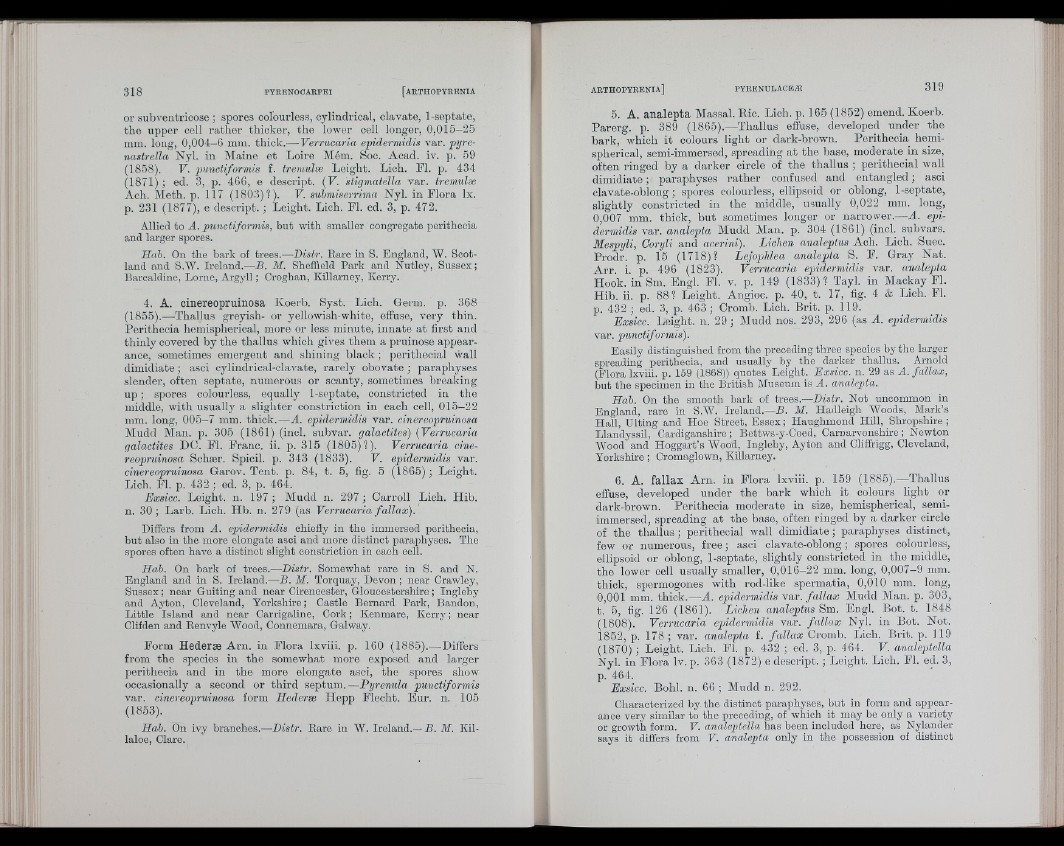
or subventricose ; spores colourless, cylindrical, clavate, 1-septate,
the upper cell rather thicker, the lower cell longer, 0,015-25
mm. long, 0,004-6 mm. thick.— Verrucaria epidermidis var. pyre-
nastreUa Nyl. in Maine et Loire Mém. Soc. Acad. iv. p. 59
(1858). V. punctiformis f. tremulse Leight. Lich. PI. p. 434
^ 8 7 1 ) ; ed. 3, p. 466, e descript. (F. stigmatella var. tremulse
Ach. Meth. p. 117 (1803)?). F. suhmiserrima Nyl. in Plora Ix.
p. 231 (1877), e descript. ; Leight. Lich. Fl. ed. 3, p. 472.
Allied to A. punctiformis, but with smaller congregate perithecia
and larger spores.
Hah. On the bark of trees.—Bistr. Eare in S. England, W. Scotland
and S.W. Ireland.—B. M. Sheffield Park and Nutley, Sussex;
Barcaldine, Lome, Argyll ; Croghan, Killarney, Kerry.
4. A. cinereopruinosa Koerb. Syst. Lich. Germ. p. 368
(1855).—Thallus greyish- or yellowish-white, effuse, very thin.
Perithecia hemispherical, more or less minute, innate a t first and
thinly covered by the thallus which gives them a pruinose appearance,
sometimes emergent and shining black ; peritheciai wall
dimidiate ; asci cylindrical-clavate, rarely obovate ; paraphyses
slender, often septate, numerous or scanty, sometimes breaking
up ; spores colourless, equally 1-septate, constricted in the
middle, with usually a slighter constriction in each cell, 015-22
mm. long, 005-7 mm. thick.—A. epidermidis var. cinereopruinosa
Mudd Man. p. 305 (1861) (incl. subvar. galactites) {Verrucaria
galactites DC. PI. Franc, ii. p. 315 (1805)?). Verrucaria cinereopruinosa
Schær. Spicil. p. 343 (1833). F. epidermidis var.
cinereopruinosa Garov. Tent. p. 84, t. 5, fig. 5 (1865) ; Leight.
Lich. Fl. p. 432 ; ed. 3, p. 464.
Exsicc. Leight. n. 197 ; Mudd n. 297 ; Carroll Lich. Hib.
n. 30; Larb. Lich. Hb. n. 279 (as Verrucaria fallax).
Differs from A. epidermidis chiefly in the immersed perithecia,
but also in the more elongate asci and more distinct paraphyses. The
spores often have a distinct slight constriction in each cell.
Hdb. On bark of trees.—Distr. Somewhat rare in S. and N.
England and in S. Ireland.—B. M. Torquay, Devon ; near Crawley,
Sussex ; near Guiting and near Cirencester, Gloucestershire ; Ingleby
and Ayton, Cleveland, Yorkshire; Castle Bernard Park, Bandon,
Little Island and near Carrigaline, Cork ; Kenmare, Kerry ; near
Clifden and Eenvyle AVood, Connemara, Galway.
Form Hederæ Am. in Plora Ixviii. p. 160 (1885).—Differs
from the species in the somewhat more exposed and larger
perithecia and in the more elongate asci, the spores show
occasionally a second or th ird septum.—Pyrenula punctiformis
var. cinereopruinosa form Hederæ Hepp Flecht. Eur. n. 105
(1853).
Hab. On ivy branches.—Distr. Eare in AV. Ireland.—R. M. Killaloe,
Clare.
5. A. analepta Massal. Rio. Lich. p. 165 (1852) emend. Koerb.
Parerg. p. 389 (1865).—Thallus effuse, developed under the
bark, which it colours light or dark-brown. Perithecia hemispherical,
semi-immersed, spreading a t the base, moderate in size,
often ringed by a darker circle of the thallus ; peritheciai wall
dimidiaie; paraphyses ra th e r confused and en tan g led ; asci
clavate-oblong; spores colourless, ellipsoid or oblong, 1-septate,
slightly constricted in the middle, usually 0,022 mm. long,
0,007 mm. thick, but sometimes longer or narrower.—A. epidermidis
var. analepta Mudd Man. p. 304 (1861) (incl. subvars.
Mespijli, Goryli and acerini). Lichen analeptus Ach. Lich. Suec.
Prodr. p. 15 (1718)? Lejophlea analepta S. P. Gray Nat.
A rr. i. p. 496 (1823). Verrucaria epidermidis var. analepta
Hook, in Sm. Engl. El. v. p. 149 (1833)? Tayl. in Mackay El.
Hib. ii. p. 88? Leight. Angioc. p. 40, t. 17, fig. 4 & Lich. Fl.
p. 432 ; ed. 3, p. 463 ; Cromb. Lich. Brit. p. 119.
Exsicc. Leight. n. 29; Mudd nos. 293, 296 (as A. epidermidis
var. punctiformis).
Easily distinguished from the preceding three species by the larger
spreading perithecia, and usually by the darker thallus. Arnold
(Flora Ixviii. p. 159 (1868)) quotes Leight. Exsicc. n. 29 as A. fallax,
but the specimen in the British Museum is A. analepta.
Hab. On the smooth bark of trees.—Rfsir. Not uncommon in
England, rare in S.AV. Ireland.—R. M. Hadleigh AVoods, Mark’s
Hall, Ulting and Hoe Street, E ssex ; Haughmond Hill, Shropshire ;
Llandyssil, Cardiganshire; Bettws-y-Coed, CarDarvonshire; Newton
AVood and Hoggart’s AVood, luglehy, Ayton and Cliffrigg, Cleveland,
Yorkshire ; Cromaglown, Killarney.
6. A. fallax Am. in Flora Ixviii. p. 159 (1885).—Thallus
effuse, developed under the bark which it colours light or
dark-brown. Perithecia moderate in size, hemispherical, semiimmersed,
spreading a t the base, often ringed by a darker circle
of the th a llu s; peritheciai wall dimidiate; paraphyses distinct,
few or numerous, fr e e ; asci clavate-oblong; spores colourless,
ellipsoid or oblong, 1-septate, slightly constricted in the middle,
the lower cell usually smaller, 0,016-22 mm. long, 0,007-9 mm.
thick, spermogones with rod-like spermatia, 0,010 mm. long,
0,001 mm. thick.—A. epidermidis var. fa lla x Mudd Man. p. 303,
t. 5, fig. 126 (1861). Lichen analeptus ^m. Engl. Bot. t. 1848
(1808). Verrucaria epndermidis var. fa lla x Nyl. in Bot. Not.
1852, p. 178; var. analepta f. fa lla x Gromb. Lich. Brit. p. 119
(1870); Leight. Lich. El. p. 432 ; ed. 3, p. 464. F. analeptella
Nyl. in Flora Iv. p. 363 (1872) e descript. ; Leight. Lich. Fl. ed. 3,
p. 464.
Exsicc. Bohl. n. 66 ; Mudd n. 292.
Characterized by the distmct paraphyses, but in form and appearance
very similar to the preceding, of which it may be only a variety
or growth form. F. analeptella has been included here, as Nylander
says it differs from F. analepta only in the possession of distinct